Exploratory Data Analysis
In the early stages of a data project, it is crucial to creating visualizations to get an insight into your data. Matploylib and seaborn are two popular Python library that makes visualization much more manageable. You can put all Visualization techniques in four different categories:
- Comparison: Either You want to compare features with each other or a single feature with itself at different time points, the most popular techniques is to use a bar chart.
- Relationship: This is when you want to see how features in your data set are changing concerning each other. Scatter plot and line plot are in this category.
- Composition: Pie chart should be the one to refer when you want to understand the composition in a feature.
- Distribution: Histograms (eight bar type or line type) and scatter plot are usually used to understand the statistical characteristics of the feature.
Here I will use these visualization techniques to get a meaning from this dataset and answer the following questions and provide evidence for our hypothesis:
Introduction to the dataset: Customer value analysis
The goal of this post is to analyze a dataset and provide some useful information regarding customers demographics and buying behaviour. I choose to work on a dataset from IBM Watson Analytics (available here). I will provide answers to assigned questions by visualization methods in Python. This dataset will show us the most profitable customers and how they interact. I will show you how you can increase profitable customer response, retention and growth. Let’s start!
import pandas as pd
import numpy as np
import os
# Load the raw data using the read_csv object
df = pd.read_csv("WA_Fn_UseC__Marketing_Customer_Value_Analysis.csv")
There is a total of 24 variables in this dataset. The variables and the description of the values are as follows:
- Customer: the customer ID number
- State
- Customer lifetime value: CLV present the finantial value of a customer. It is a prediction of the net profit attributed to the customer during his/her entire relationship with the company. CLV is highly important in shaping managers’ decisions.
- Reponse: Yes or no response
- Coverage: coverage type eigher basic, Premium, or extended
- Education
- Effective to Date
- Employmnet status
- Employed or unemployed
- Gender: F or M
- Income
- Location Code
- Marital Status
- Monthly Premium Auto
- Months Since Policy inception
- Number of Open Complaints
- Number of Polices
- Policy Type
- Policy
- Renew Offer Type
- Sales Channel
- Total Claim Amount
- Vehicle Class
- Vehicle Size
df.head()
| Customer | State | Customer Lifetime Value | Response | Coverage | Education | Effective To Date | EmploymentStatus | Gender | Income | ... | Months Since Policy Inception | Number of Open Complaints | Number of Policies | Policy Type | Policy | Renew Offer Type | Sales Channel | Total Claim Amount | Vehicle Class | Vehicle Size | |
|---|---|---|---|---|---|---|---|---|---|---|---|---|---|---|---|---|---|---|---|---|---|
| 0 | BU79786 | Washington | 2763.519279 | No | Basic | Bachelor | 2/24/11 | Employed | F | 56274 | ... | 5 | 0 | 1 | Corporate Auto | Corporate L3 | Offer1 | Agent | 384.811147 | Two-Door Car | Medsize |
| 1 | QZ44356 | Arizona | 6979.535903 | No | Extended | Bachelor | 1/31/11 | Unemployed | F | 0 | ... | 42 | 0 | 8 | Personal Auto | Personal L3 | Offer3 | Agent | 1131.464935 | Four-Door Car | Medsize |
| 2 | AI49188 | Nevada | 12887.431650 | No | Premium | Bachelor | 2/19/11 | Employed | F | 48767 | ... | 38 | 0 | 2 | Personal Auto | Personal L3 | Offer1 | Agent | 566.472247 | Two-Door Car | Medsize |
| 3 | WW63253 | California | 7645.861827 | No | Basic | Bachelor | 1/20/11 | Unemployed | M | 0 | ... | 65 | 0 | 7 | Corporate Auto | Corporate L2 | Offer1 | Call Center | 529.881344 | SUV | Medsize |
| 4 | HB64268 | Washington | 2813.692575 | No | Basic | Bachelor | 2/3/11 | Employed | M | 43836 | ... | 44 | 0 | 1 | Personal Auto | Personal L1 | Offer1 | Agent | 138.130879 | Four-Door Car | Medsize |
5 rows × 24 columns
# the size or structure of the dataset: 24 columns and over 9000 rows.
df.shape
(9134, 24)
Dataset comprises of 9134 observations and 24 characteristics.
investigating the dataset
Now, I will get some basic information regarding this dataset.
df.isnull().sum()
Customer 0
State 0
Customer Lifetime Value 0
Response 0
Coverage 0
Education 0
Effective To Date 0
EmploymentStatus 0
Gender 0
Income 0
Location Code 0
Marital Status 0
Monthly Premium Auto 0
Months Since Last Claim 0
Months Since Policy Inception 0
Number of Open Complaints 0
Number of Policies 0
Policy Type 0
Policy 0
Renew Offer Type 0
Sales Channel 0
Total Claim Amount 0
Vehicle Class 0
Vehicle Size 0
dtype: int64
The dataset looks clean since there is no NaN value in our feature culumns. The data types have been also properly assigned.
df.dtypes
Customer object
State object
Customer Lifetime Value float32
Response object
Coverage object
Education object
Effective To Date object
EmploymentStatus object
Gender object
Income int64
Location Code object
Marital Status object
Monthly Premium Auto int64
Months Since Last Claim int64
Months Since Policy Inception int64
Number of Open Complaints int64
Number of Policies int64
Policy Type object
Policy object
Renew Offer Type object
Sales Channel object
Total Claim Amount float64
Vehicle Class object
Vehicle Size object
dtype: object
Exploring the features
Now lets build up some graphs to explore the features (variables).
import seaborn as sb
import scipy
from scipy.stats.stats import pearsonr
from scipy.stats import spearmanr
from scipy.stats import chi2_contingency
from IPython.display import display
pd.options.display.max_columns = None
import matplotlib.pyplot as plt
sb.set()
import pylab as pl
from pylab import rcParams
from matplotlib import cm
import plotly.graph_objs as go
import plotly.offline as py
import os
import plotly.tools as tls
import plotly.figure_factory as ff
import matplotlib.ticker as mtick
%matplotlib inline
#rcParams['figure.figsize'] = 28, 4
sb.set_style('whitegrid')
df["Vehicle Class"].value_counts()
Four-Door Car 4621
Two-Door Car 1886
SUV 1796
Sports Car 484
Luxury SUV 184
Luxury Car 163
Name: Vehicle Class, dtype: int64
df["Education"].value_counts()
Bachelor 2748
College 2681
High School or Below 2622
Master 741
Doctor 342
Name: Education, dtype: int64
df["Coverage"].value_counts()
Basic 5568
Extended 2742
Premium 824
Name: Coverage, dtype: int64
df["State"].value_counts()
California 3150
Oregon 2601
Arizona 1703
Nevada 882
Washington 798
Name: State, dtype: int64
df["Customer Lifetime Value"].mean()
8004.93017578125
The describe() function in pandas is useful in getting various statistics. As shown below, this function returns the count, mean, standard deviation, minimum and maximum values and the quantiles of the dataset. We can see that a notably large difference between 75% tile and max values of most of our features. This point implies that we have some Outliers in our data set.
df.describe()
| Customer Lifetime Value | Income | Monthly Premium Auto | Months Since Last Claim | Months Since Policy Inception | Number of Open Complaints | Number of Policies | Total Claim Amount | |
|---|---|---|---|---|---|---|---|---|
| count | 9134.000000 | 9134.000000 | 9134.000000 | 9134.000000 | 9134.000000 | 9134.000000 | 9134.000000 | 9134.000000 |
| mean | 8004.930176 | 37657.380009 | 93.219291 | 15.097000 | 48.064594 | 0.384388 | 2.966170 | 434.088794 |
| std | 6870.965820 | 30379.904734 | 34.407967 | 10.073257 | 27.905991 | 0.910384 | 2.390182 | 290.500092 |
| min | 1898.007690 | 0.000000 | 61.000000 | 0.000000 | 0.000000 | 0.000000 | 1.000000 | 0.099007 |
| 25% | 3994.251831 | 0.000000 | 68.000000 | 6.000000 | 24.000000 | 0.000000 | 1.000000 | 272.258244 |
| 50% | 5780.182129 | 33889.500000 | 83.000000 | 14.000000 | 48.000000 | 0.000000 | 2.000000 | 383.945434 |
| 75% | 8962.166992 | 62320.000000 | 109.000000 | 23.000000 | 71.000000 | 0.000000 | 4.000000 | 547.514839 |
| max | 83325.382812 | 99981.000000 | 298.000000 | 35.000000 | 99.000000 | 5.000000 | 9.000000 | 2893.239678 |
Data visualization
This was just a glimpse of this dataset. Let’s use visualization methods in Python and explore data with some graphs. Python’s Seaborn library, built on top of matplotlib, will be used to get statistical graphs to perform Univariate and Multivariate analysis.
sb.pairplot(df)
<seaborn.axisgrid.PairGrid at 0x1a27ead860>

df.corr()
| Customer Lifetime Value | Income | Monthly Premium Auto | Months Since Last Claim | Months Since Policy Inception | Number of Open Complaints | Number of Policies | Total Claim Amount | |
|---|---|---|---|---|---|---|---|---|
| Customer Lifetime Value | 1.000000 | 0.024366 | 0.396262 | 0.011517 | 0.009418 | -0.036343 | 0.021955 | 0.226451 |
| Income | 0.024366 | 1.000000 | -0.016665 | -0.026715 | -0.000875 | 0.006408 | -0.008656 | -0.355254 |
| Monthly Premium Auto | 0.396262 | -0.016665 | 1.000000 | 0.005026 | 0.020257 | -0.013122 | -0.011233 | 0.632017 |
| Months Since Last Claim | 0.011517 | -0.026715 | 0.005026 | 1.000000 | -0.042959 | 0.005354 | 0.009136 | 0.007563 |
| Months Since Policy Inception | 0.009418 | -0.000875 | 0.020257 | -0.042959 | 1.000000 | -0.001158 | -0.013333 | 0.003335 |
| Number of Open Complaints | -0.036343 | 0.006408 | -0.013122 | 0.005354 | -0.001158 | 1.000000 | 0.001498 | -0.014241 |
| Number of Policies | 0.021955 | -0.008656 | -0.011233 | 0.009136 | -0.013333 | 0.001498 | 1.000000 | -0.002354 |
| Total Claim Amount | 0.226451 | -0.355254 | 0.632017 | 0.007563 | 0.003335 | -0.014241 | -0.002354 | 1.000000 |
sb.heatmap(df.corr(), xticklabels=df.corr().columns.values, yticklabels=df.corr().columns.values, annot=True)
<matplotlib.axes._subplots.AxesSubplot at 0x1a2d7df0b8>

spearmanr(df["Customer Lifetime Value"], df["Total Claim Amount"])
SpearmanrResult(correlation=0.2105979582520612, pvalue=4.351847002636142e-92)
chi2_contingency
<function scipy.stats.contingency.chi2_contingency>
table = pd.crosstab(df.Gender,df["EmploymentStatus"])
table
| EmploymentStatus | Disabled | Employed | Medical Leave | Retired | Unemployed |
|---|---|---|---|---|---|
| Gender | |||||
| F | 244 | 2937 | 214 | 128 | 1135 |
| M | 161 | 2761 | 218 | 154 | 1182 |
chi2, p, dof, expected = chi2_contingency(table.values)
rcParams['figure.figsize'] = 14, 5
gb = df.groupby("Gender")["Education"].value_counts().to_frame().rename({"Education": "Numbers"}, axis = 1).reset_index()
gb
| Gender | Education | Numbers | |
|---|---|---|---|
| 0 | F | Bachelor | 1423 |
| 1 | F | College | 1352 |
| 2 | F | High School or Below | 1321 |
| 3 | F | Master | 393 |
| 4 | F | Doctor | 169 |
| 5 | M | College | 1329 |
| 6 | M | Bachelor | 1325 |
| 7 | M | High School or Below | 1301 |
| 8 | M | Master | 348 |
| 9 | M | Doctor | 173 |
sb.barplot(x = "Gender", y = "Numbers", data = gb, hue = "Education", palette = sb.color_palette("hls", 9)).set_title("Education vs. Gender");
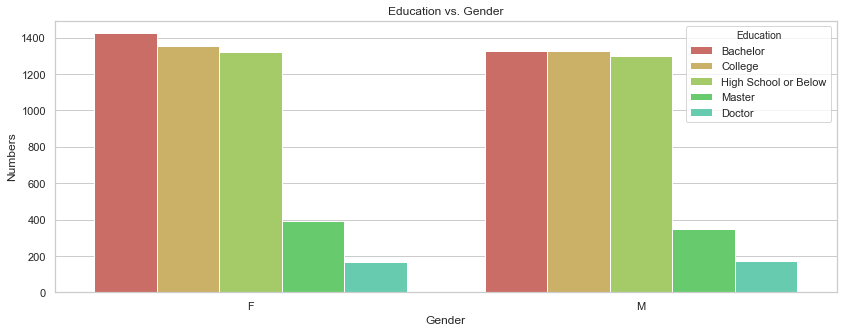
rcParams['figure.figsize'] = 12, 5
gb = df.groupby("Vehicle Class")["Vehicle Size"].value_counts().to_frame().rename({"Vehicle Size": "Numbers"}, axis = 1).reset_index()
sb.barplot(x = "Vehicle Class", y = "Numbers", data = gb, hue = "Vehicle Size", palette = sb.color_palette("hls", 3)).set_title("Education vs. Gender");
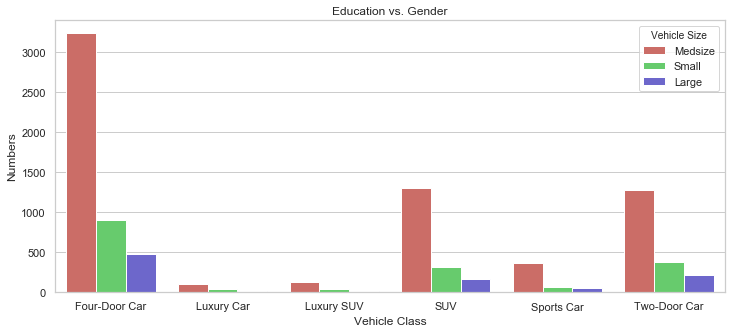
rcParams['figure.figsize'] = 12, 5
gb = df.groupby("Vehicle Class")["Coverage"].value_counts().to_frame().rename({"Coverage": "Numbers"}, axis = 1).reset_index()
sb.barplot(x = "Vehicle Class", y = "Numbers", data = gb, hue = "Coverage", palette = sb.color_palette("hls", 12)).set_title("Education vs. Gender");

rcParams['figure.figsize'] = 12, 5
gb = df.groupby("Vehicle Size")["Coverage"].value_counts().to_frame().rename({"Coverage": "Numbers"}, axis = 1).reset_index()
sb.barplot(x = "Vehicle Size", y = "Numbers", data = gb, hue = "Coverage", palette = sb.color_palette("hls", 7)).set_title("Education vs. Gender");

rcParams['figure.figsize'] = 10, 5
gb = df.groupby("Policy")["Policy Type"].value_counts().to_frame().rename({"Policy Type": "Numbers"}, axis = 1).reset_index()
sb.barplot(x = "Policy", y = "Numbers", data = gb, hue = "Policy Type", palette = sb.color_palette("hls", 5)).set_title("Education vs. Gender");
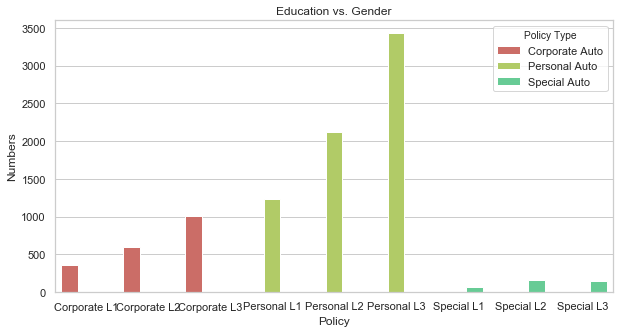
gb = df.groupby("State").agg({"Customer Lifetime Value":'mean'}).rename({"Customer Lifetime Value": "Customer Lifetime Value Mean"}, axis = 1).reset_index()
gb
| State | Customer Lifetime Value Mean | |
|---|---|---|
| 0 | Arizona | 7861.341309 |
| 1 | California | 8003.647949 |
| 2 | Nevada | 8056.707031 |
| 3 | Oregon | 8077.901367 |
| 4 | Washington | 8021.472168 |
sb.set(style="whitegrid")
sb.barplot(x = "State", y = "Customer Lifetime Value Mean", data = gb, hue = "Customer Lifetime Value Mean" , palette = sb.color_palette("hls", 5)).set_title("The Mean value of the Customer Lifetime Value in each state");
#plt.legend(loc='best')
plt.legend(bbox_to_anchor=(1.05, 1), loc=2, borderaxespad=0.)
<matplotlib.legend.Legend at 0x1a2ba6beb8>
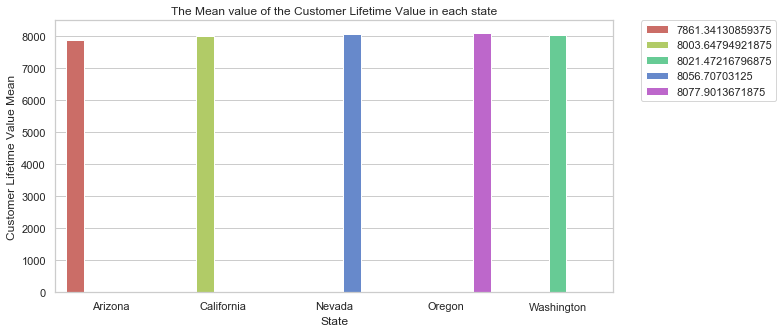
sb.catplot(x="Customer Lifetime Value",y="Policy",data=df)
<seaborn.axisgrid.FacetGrid at 0x1a2b53e668>
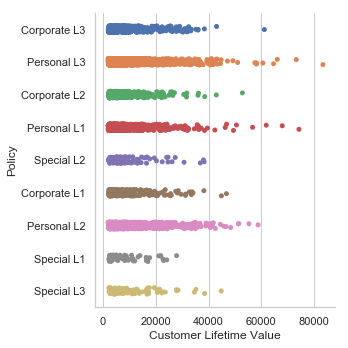
g = sb.relplot(x="Monthly Premium Auto", y="Customer Lifetime Value",size='Income', kind="scatter", data=df)
g.fig.autofmt_xdate()
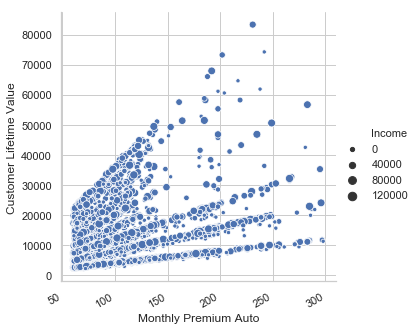
df["Customer Lifetime Value"]=df["Customer Lifetime Value"].astype('float32')
CLVunder10000 = df["Customer Lifetime Value"][(df["Customer Lifetime Value"] <= 10000.0)]
CLV10000_20000 = df["Customer Lifetime Value"][(df["Customer Lifetime Value"] <= 20000.0) & (df["Customer Lifetime Value"] >= 10000.1)]
CLV20000_40000 = df["Customer Lifetime Value"][(df["Customer Lifetime Value"] <= 40000.0) & (df["Customer Lifetime Value"] >= 20000.1)]
CLV40000_60000 = df["Customer Lifetime Value"][(df["Customer Lifetime Value"] <= 60000.0) & (df["Customer Lifetime Value"] >= 40000.1)]
CLVabove60000 = df["Customer Lifetime Value"][df["Customer Lifetime Value"] >= 60000.1]
CLV_range = ["1898(min)_ 10000","10000_20000","20000_40000","40000_60000","60000-83325 (max)"]
CLV_count = [len(CLVunder10000.values),len(CLV10000_20000.values),len(CLV20000_40000.values),len(CLV40000_60000.values),len(CLVabove60000.values)]
plt.figure(figsize=(8,5))
plt.bar(CLV_range, CLV_count, width=0.7, color = "black", align='center')
plt.show()

CLV_count
[7248, 1311, 515, 51, 9]
df["Customer Lifetime Value"].describe()
count 9134.000000
mean 8004.930176
std 6870.965820
min 1898.007690
25% 3994.251831
50% 5780.182129
75% 8962.166992
max 83325.382812
Name: Customer Lifetime Value, dtype: float64
sb.catplot(x="Customer Lifetime Value", y="Coverage", hue="State", kind="swarm", data=df);

sb.catplot(x="Customer Lifetime Value",y="Marital Status",kind='box',data=df)
<seaborn.axisgrid.FacetGrid at 0x1a2b7d52e8>
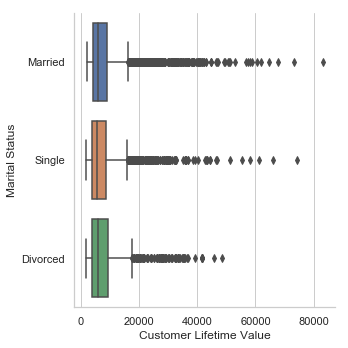
sb.catplot(x="Customer Lifetime Value",y="Marital Status", hue = "Gender", kind='box',data=df)
<seaborn.axisgrid.FacetGrid at 0x1a2b8c2940>
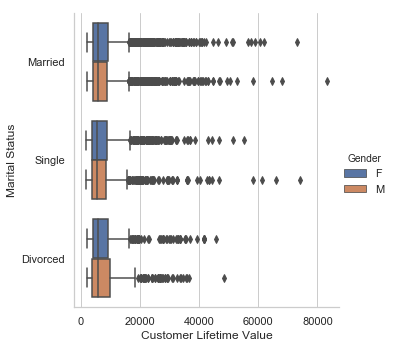
sb.catplot(x="Customer Lifetime Value",y="EmploymentStatus",kind='violin',data=df)
<seaborn.axisgrid.FacetGrid at 0x1a2c52f080>

rcParams['figure.figsize'] = 14, 8
ax = sb.catplot(y='Monthly Premium Auto',x='Months Since Policy Inception',hue='Gender',kind='point',data=df)
ax.fig.autofmt_xdate()
ax.
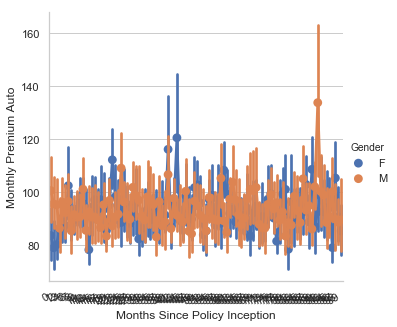
sb.catplot(x="Sales Channel", y="Customer Lifetime Value", hue="Renew Offer Type", kind="swarm", data=df);
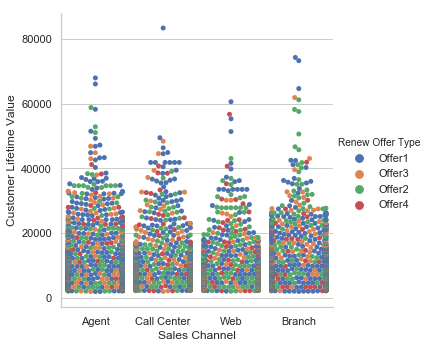
df2=df[['Monthly Premium Auto', 'Months Since Last Claim', 'Months Since Policy Inception', 'Number of Open Complaints', 'Number of Policies', 'Customer Lifetime Value', 'Income', 'Total Claim Amount' ]]
number_of_rows=1
number_of_columns=8
l = df2.columns.values
plt.figure(figsize=(6*number_of_columns,8*number_of_rows))
for i in range(0,len(l)):
plt.subplot(number_of_rows + 1,number_of_columns,i+1)
sb.distplot(df[l[i]],kde=True)

l = df2.columns.values
number_of_columns=8
number_of_rows = 1
plt.figure()
for i in range(0,len(l)):
plt.subplot(number_of_rows + 1,number_of_columns,i+1)
sb.set_style('whitegrid')
sb.boxplot(df2[l[i]],color='green',orient='v')
plt.tight_layout()


